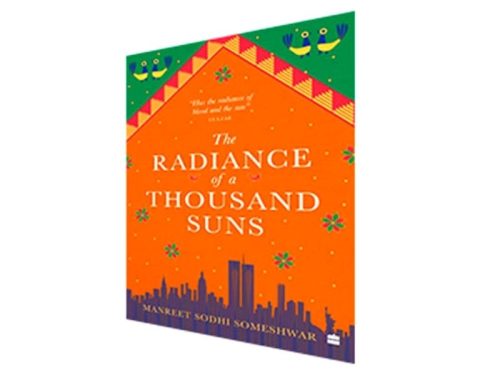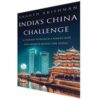Wounds of history: The radiance of a thousand suns
 – Ravi Menon (The Book Review)
– Ravi Menon (The Book Review)
This novel has several interwoven themes — communities turning against each other, exploitation of women and the concept of nationhood. Three women bring them alive
The radiance of a thousand suns; Manreet Sodhi Someshwar; Harper Collins
Rs.499; Pages 499
In July 1947 an accomplished lawyer from England made his first, and only, visit to India. When he departed after five weeks he left behind a boundary line which created two new countries. The Partition would result in the largest communal massacre and human migration of the 20th century and would affect the lives of millions for decades. The lawyer’s lack of knowledge of India and the short time allotted to his task, are often cited as an example of how this decision was taken.
It can be argued that while the process of Partition has been exhaustively examined, the horrors and misdeeds that were perpetrated by the ordinary people of India and Pakistan (the Punjab in particular) in 1946-47 have never been properly acknowledged. The Radiance of a Thousand Suns by Manreet Sodhi Someshwar invites the reader to revisit the sights and sounds of this dark era.
The book has several inter-woven themes — communities turning against each other, exploitation of women and the concept of nationhood. The author uses the backdrop of the Partition, the riots of 1984 and the ordeals of three women to bring them alive. The theme of brother turning against brother is anchored by references to brief episodes from the Mahabharata.
This is the story of an upper middle-class Sikh family, the Nalwas. The father is a lawyer, whose specialty is civil rights cases. He is compiling a book of oral histories of the victims of the Partition riots and the riots of ’84 in order to bring these into public discourse. When he dies, his book incomplete, his daughter Niki makes it her mission to complete the task.
Historical events whether it is the Partition, the 1971 War or Emergency touch the Nalwa family at various stages. Niki’s grandmother Dadima helps rehabilitate children orphaned or abandoned during the Partition and the ’84 riots. Thus they are Sikhs by birth but in action seek to act as if the world does not recognise any religion. They take into their household a young Muslim woman Nooran, who works for them but is almost a family member.
Nooran herself is in many ways the focal character of young Niki’s life. In times of crisis she asks herself ‘What would Nooran do?’ Nooran is unconventional. Her complexion ‘like the underside of a griddle’ did not detract from her self-confidence in a land where light complexion was prized and women were conditioned to please men. She looked the world in the eye, her attitude exemplified in her walk.
‘Punjabi women normally tiptoed around their men but Nooran strode like an unapologetic peacock.’ The embroidery Nooran works on — the only item she could retrieve from her house where her family was butchered by rioters, plays an important role in Niki’s life and the story.
With such people in her upbringing it is little wonder that Niki is attracted to the notion of doing right and standing up for women. Post her MBA she lands a job in a consultancy firm, marries, accompanies her husband to Hong Kong and New York where she takes a sabbatical to complete her father’s unfinished work.
If the thesis of the book is that the wounds of Partition have been glossed over by posterity, the underlying theme is the status of women as they navigate their role in society. The book pauses in its narrative ever so often for characters to highlight the role of women. The issue of female foeticide or the case of the forgotten population is powerfully covered at one point. At another point Niki thinks, ‘History is like a woman, substantial, vigorous, complex and always given the customary short shrift.’
Niki’s task brings the third woman of this book into her life. Her father’s plan had been to locate one narrative which would serve as ‘the spine’ of the book — that is, one narrative of a victim of the Partition as well as the 1984 Delhi riots. This is Jyot who sees her family killed by her father to prevent them from falling into the hands of marauding Muslims. She survives and is found on a mound of bodies by her uncle. She is raised in a gurudwara, trains to work in a hospital and is finally taken to New York where she works with an organisation helping immigrants to settle.
Niki joins this organisation to establish contact with Jyot and record her story. She meets a dour, withdrawn person who refuses to communicate. Traumatic events finally make Jyot open up to reveal her secrets.
The concept of national identity is poignantly captured in the story of a Sikh cab driver Niki meets in New York. He is the archetypal immigrant from Punjab who has followed the three pillars of Sikhism — work hard, share with others, contemplate God — all his life. He has worked unearthly hours and shared rooms with three others to save money to send home so that his family can build a brick house.
In a tragic commentary on India he says, ‘….. I am American now. I go back to my des, my India, every few years, but this is where I belong. When I first came here all you had to do was to arrive and you were American. All the people here are like streams from across the world which have ended up in the Hudson. But in India you have to be Indian to be Indian.’
The book ends on a triumphant note as Niki’s daughter makes an addition to Nooran’s embroidered cloth — a sun. This follows a conversation in which Niki tells her daughter that Oppenheimer’s first thought when he saw the atom bomb explode in the desert was a line from the Bhagvad Gita: ‘If the radiance of a thousand suns…’. To Niki this was an appropriate description of the beacon in her life.
This book leaves us with the grim knowledge that we forget the events of Partition at our peril. If communities united by culture can be divided by religion in an instant, the very idea of India as a nation is in danger. The only way forward is to internalise the eternal truth ‘we are one’ and put it into action. Or to remember the immortal line from the Mundaka Upanishad ‘…like a thousand sparks from a blazing fire are we…’
Also read: Tale of two nations: India’s China challenge
















Add comment